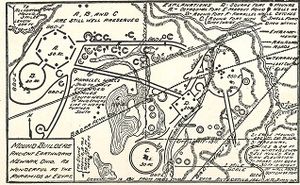Mound Builders
Licking County was undoubtedly the center of a great community of Moundbuilders. Evidenced not only by the great number of ancient earthworks, but also by the elaborate mound system that runs through the western part of Newark. The only two remaining mounds in the county are the circle at Moundbuilders Park and the circle and octagon at Moundbuilders Country Club.
Adena
The first white men in Licking County found nearly three hundred mounds, during the first era of discovery in the early 1800s. The Moundbuilders lived in the areas around the Ohio Valley somewhere between 500 and 2000 years ago. The first major mound builders were the Adena, named from Ohio's first governor, Thomas Worthington, where the first mound was excavated on his estate. [1] Nearly 500 Adena sites have been studied across the country, and their mounds have dated back as far as 800 B.C.E. The Adena were talented hunters and fisherman, and analysis of their skeletons show them to have stood nearly seven feet tall. [2]
Around 500 B.C., the Adena began building conical mounds as for burial purposes. [2] The mounds were often surrounded by great earthen ridges, though the purpose of the ridges is not known. The mounds were used to honor the remains of prominent members of the Adena society including chiefs, shaman, and priests. Early on, the dead were buried in bark lined pits, covered with slabs of bark and covered with earth to form a mound. Later on these tactics evolved and the dead were buried in log tombs, layered atop each other, until the mounds were 30 to 70 feet tall. [2]
Hopewell
From the Adena culture, evolved the Hopewell Tribe who lived between 200 B.C. and 500 A.D.. The group got their name in the 1890s when thirty eight mounds were found on the farm of Captain Mordecai Hopewell near Chillicothe. The sprawling mound group found there revealed many characteristics of a sophisticated society of engineers and artists who designed the mounds for burials. Like the Adena, the Hopewell were not one group of people but a broad network of different prehistoric Native American tries who traded and shared a unifying set of symbols and beliefs. [3]
Many of the habits and rituals of the Hopewell were similar to their forebearers, the Adena. Although unlike the Adena, they had a strict class system and division of labor that dominated their society. The Hopewells lived in small settlements scattered along the Ohio River valley near their mounds and earthworks. [3]
The Newark Earthworks is a Hopewell complex of several large compounds that encompasses four square miles. Scientists believe the earthworks was once a great Hopewell road that connected the Newark mounds to those in Chillicothe, some 60 miles away. [3] Moundbuilders State Park in Newark preserves what is left of the original complex. The Newark mound runs 1200 feet in diameter, encloses 30 acres and rises 12 feet above the average level of the ground it encloses. There is also an opening nearly 80 feet wide on the eastern side. [4] Other prominent Hopewell mounds include the Mica Grave Mounds, the Mound of Pipes and Long Mound. The Hopewell culture disappeared sometime between A.D. 500 and 600. [5]
References
- ↑ Lore, D. (1997, May 10). Mound builders' label don't fit anymore, professor contends. The Columbus Dispatch.
- ↑ 2.0 2.1 2.2 Kavasch, E. (2004). Adena Mound Building Culture (1000-100 B.C.). In The Mound Builders of Ancient North America. Lincoln, NE: IUniverise.
- ↑ 3.0 3.1 3.2 Kavasch, E. (2004). Hopewell Mound Building Culture (200 B.C.-A.D. 500). In The Mound Builders of Ancient North America. Lincoln, NE: IUniverise.
- ↑ The Ancient Mounds In and Around the City of Newark Ohio. (1964, April 24). The Newark Chamber of Commerce.
- ↑ Ohio Historical Society, (1993). The Newark Earthworks. Columbus, Ohio.
